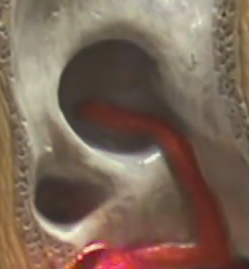Endosteum is a thin, soft connective tissue present in the open spaces within long bones. It helps in varied processes like fracture healing and production of new cells needed for fusion of bones. Also, endosteum has HSCs or haematopoietic stem cells which play a vital role in the production of all types of blood cells.
Medically referred to as the medullary membrane or medullary cavity, the endosteum is located in the cavity or diaphysis of the long bones. This shaft or cavity has yellow and red bone marrow and it’s linings consist of spongy bones or cancellous bones, which makes up about 20 % of the total weight of the skeleton.
Location and types of endosteum
The endosteum is found in the inside section of bones. It is the layer of membrane that covers the spongy area of bone, the medullary cavity, the internal linings of long compact bones, and the haversian canals. It occurs in bones like the femur, humerus, hip bones, ribs or thoracic bones, and sesamoid bones like the patella. In the skull, it is found as lining the walls of the different cavities.
There are 3 types of endosteum, i.e., osteonal,cortical, and trabecular; the nomenclature of these types refers to the inner bone area where it occurs.
- The cortical endosteum is present on the internal walls of the cortical bone and acts as the border of the marrow cavity. The yellow bone marrow present in this hollow space helps store fat cells. During severe malnutrition, the body uses these cells as fuel for energy.
- The reabsorption of endosteum during extreme malnutrition reduces the bone density and thickness. This causes a decrease in the bone’s cortical thickness which is very harmful as the cortical bone plays a vital role in varied important functions like storage and release of calcium. Also, as the weight of the cortical bone is about 80 percent of the total weight of the skeleton, the overall weight of the patient is also significantly reduced.
- The osteonal endosteum occurs on the osteonal canals’ inner walls, which are present in compact bone and contain the nerve and blood supplies of the bone.
- The trabecular endosteum line the inner walls of the trabeculae, which are bony bars that cover the spongy section of the bone next to the shaft and thus help absorb and reduce bone damage from impact. It has red marrow containing HSCs that help produce new blood cells.
The functions of the endosteum
Some of the common functions of the endosteum are listed below:
- Bone repair: The osteogenic properties of endosteum help it to play a major role in healing fractures of different types, bone repair, and bone growth. Occurrence of hematoma within the bone causes increased production of endosteal cells which in turn work towards establishment of reparatory callus as well as in aiding the process of bone consolidation.
- The process of harvesting bone marrow causes mechanical fracture of the bony trabeculae and damages it. Even in this scenario, the endosteum helps the process of bone repair by promoting the creation of osteoclast and osteoblast cells.
- Other functions: It helps stimulate hematopoietic cells production.
- It stimulates overall bone growth. The thin connective tissue layer promotes widthwise growth of bones.
- It stimulates the osteons occurring in the cortical bone and thus permits the appositional bone development.
- By reabsorbing the bone, the endosteum works with the periosteum to stimulate and promote development of new bone. This means that it has an important role to play in remodeling of bones.
Endosteum vs. Periosteum
While the endosteum is present inside the bone cavity, the periosteum is the firm and durable part present outside the bone. It produces cells that help bone reconstruction and thus is also vital to the process of fracture healing.
Some of the differences between the periosteum and the endosteum are as follows:
- As opposed to the location of the endosteum as discussed above, the periosteum is situated on the bone’s outer surface, with articular areas being the exception. The latter is also not present on the knee patella and other sesamoid bones.
- The periosteum is thicker than the endosteum; the thickness of the former varies in the range of 0.1 to 0.5 mm, while the latter is 0.01 mm thick.
- The endosteum has loosely arranged connective tissue and is made up of endosteal cells in a single layer. Periosteum structure is more complex and consists of 2 layers of periosteal cells. One layer has huge amounts of periosteal cells while the 2ndlayer is fibrous. Also, the connective tissue associated with the periosteum is irregularly arranged and dense.
- The periosteum works with the endosteum and helps it in all its varied functions of bone repair, etc. Additionally, it also passes on essential nutrients to the skeleton and plays a role in bone sensitivity.

